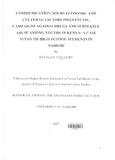| dc.description.abstract | This study sought to examine the communication, socio-economic and cultural factors
influencing campaigns against drugs and substance abuse with a particular focus on
students in high schools in Nairobi. In particular it sought to determine the
communication strategies used in the campaigns, what impact communication regarding
drugs has had on youth's knowledge, attitudes, beliefs and practices, the communication
habits among youth in relation to drug information and the role socio-economic and
gender factors play in the risk behaviour associated with drugs.
Some 350 self-administered questionnaires were sending out, and 299 were returned
constituting a return rate of 85%. However, data analysis was done on only 252
questionnaires whose respondents duly completed, the rest being spoiled.
Findings of the data show that majority of students actually are aware of the health
hazards drug use/abuse certainly cause. Responses indicate majority of the students find
drug repulsive. Intriguingly, however, 77% of the respondents know friends who were
having a drug related problem, with some seeking help from teachers, friends or simply
having apparently resigned to the problem. While over 70% of the respondents were exposed to Television and over 50% to radio on
daily basis, only 15% of the respondents said they g.,.ot most of their drug information
from television while only 4% got theirs from radio. Majority of the respondents said
they got most of the drug information they had from the teachers.
The inference that could be made from these findings are that although communication
has played a role in creating awareness about the health hazards of drug use/abuse, the
awareness so produced has not had any appreciable effect on behaviour. Over half of the
students had in fact drunk alcohol in the past one year, while 22 % of the respondents had
in fact drunk alcohol within the two weeks prior to the study and 15% within a month
prior to the study which was done the first week ofthird in 2007. The upshot of all these findings is that the government, Non-governmental organisations,
parents and schools are up against a Herculean task: new thinking and strategies is
urgently needed in order to save the youth from the ravages of the drug scourge. | en |

